.jpg?width=1170&name=i2_small%20(1).jpg) Since the strike of COVID-19, traditional sports broadcasters have adopted cloud-based workflows at a very high pace as compared to the situation before.
Since the strike of COVID-19, traditional sports broadcasters have adopted cloud-based workflows at a very high pace as compared to the situation before.The COVID-19 pandemic has, and continues to cause an unprecedented disruption across many industries of the global economy. TV broadcasts, also called linear broadcasts, have continued to excel owing to the current state of affairs where people are stuck indoors, and always on their televisions.
However, the situation is different behind the scenes. The economic strain has forced advertisers to minimize their spending on advertisement, which has affected broadcasters’ budgets. Therefore, broadcasters have had to rethink how they deliver their programming to their viewers. Traditional broadcast workflows are both unscalable—because viewers are consuming more content than ever, and unsustainable—especially in sports broadcasting because broadcasting cost has to be scaled down.
Since the strike of COVID-19, traditional sports broadcasters have adopted cloud-based workflows at a very high pace as compared to the situation before.
The widespread introduction of this technology will have a profound and positive effect on sports broadcasters. This will create a flexible and cost-effective working environment, which can keep up with the new age of content delivery via OTT and live streaming services.
 The COVID-19 pandemic is causing unprecedented disruption across many industries.
The COVID-19 pandemic is causing unprecedented disruption across many industries.
To talk about graphics in this modern era, you have to address the impact of OTT (Over-The-Top) vs. linear broadcast content delivery, and how this movement is going to shape the technologies involved in sports production of the future.
In a nutshell, OTT is the act of bypassing (going over-the-top of) traditional methods of content delivery (free-to-air, satellite TV, etc.) Instead, content delivery makes its way to the viewer via the internet. The most important feature of an OTT content delivery service is its superior ability to deliver as much live content as you can capture to your viewers.
The best way to understand the essence of OTT over linear broadcast content delivery is by comparing how each technology powers a 'channel' of content.‘ But before that, what is a channel? It’s a single feed of live video content that a viewer consumes. Between the two, OTT provides better functionalities over traditional Linear Broadcast Channels.
This is a channel that a viewer would receive via free-to-air, cable, or satellite television. The disadvantages of using this channel arises due to its complexity to operate, high cost required for licensing of frequencies, and purchasing of transmission equipment. Its complexity implies that it can only be operated by specialists, which is an additional cost.
The nature of the technology powering a single linear channel limits the broadcaster’s ability to scale up the amount of simultaneous content-delivery they can achieve.
.jpg?width=1200&name=TV_STATION_SMALL%20(1).jpg) Linear broadcast television channels are expensive and complex to operate.
Linear broadcast television channels are expensive and complex to operate.Think of an OTT channel as a single live stream you would watch on a platform like YouTube. There may be millions of live streams happening around the world at one time, but you are viewing one of them. The key-word in the sentence above is 'millions.'
Now, a broadcaster hypothetically has the power to launch 'millions' of content channels through OTT content delivery, which is by far a capability that cannot be supported by traditional linear broadcast technologies.
The technology that powers this ecosystem is highly scalable and flexible. This in turn brings down the cost-per-channel significantly, hence allowing the broadcaster to run more channels. Thanks to OTT content delivery.
 OTT content delivery: highly scalable and sustainable.
OTT content delivery: highly scalable and sustainable.
However, it also raises some concerns about the cost of producing the content. Traditional live broadcast production workflows are fundamentally incompatible with the scalability and potential supported by OTT. A current live broadcast for a single sporting event may have hundreds of on-site specialist-personnel and Outside Broadcast trucks (OB Trucks) which are quite essential in facilitating remote broadcasts. These factors limit its scalability.
On the contrary, the OTT world requires highly scalable, vertically integrated technology that can replicate in a non-linear cost structure—reduction in the cost of production with an increase in volume. The main setback of traditional live graphics production technologies is that their traditional graphic solutions are resource-heavy technologies. This is an unscalable solution that isn't fit to serve the rapid expansion of live-sports content-consumption. The full power of OTT can be achieved by adopting features such as live graphics.
In essence, live sports broadcasters are calling for more advanced technologies to meet the demands of OTT content delivery, so as to facilitate effective streaming of live graphics during production. And actually, that’s why we came up with LIGR.Live.
We figured out what the tomorrow of live sports will be and incorporated some great features into the LIGR.Live. These feature include:
So, what does 100% cloud-based imply, and why is it important?
In this day and age, most people are familiar with what 'the cloud' is and what it entails. Cloud-computing powers many aspects of our modern lives. For instance, if you have a business, it’s no longer necessary to have an on-site email or a storage server. All you need to do is sign up on platforms such as G Suit, Dropbox, etc. They assign you an email and cloud storage instantly so you no longer need on-site servers.
 Cloud technologies enable companies to remove the need for expensive onsite infrastructure.
Cloud technologies enable companies to remove the need for expensive onsite infrastructure.
Broadcast-specific technologies have started to take advantage of 'the cloud' by using it for storage or for connecting between an outside-broadcast and facilities at their offices. For instance, a traditional graphics solution that takes advantage of the cloud may source assets and data from the cloud. However, the solution still requires on-site graphics rendering hardware and controllers, which means it’s not 100% cloud-graphics. The next generation of broadcast technologies needs to integrate 100% cloud-graphics to meet the scalability requirements necessary for OTT content delivery.
Now, LIGR.Live is the next-generation, 100% cloud-graphics solution for live sports broadcasts. LIGR's graphics rendering and control interfaces are 100% hosted in the cloud. All the user needs is any web-enabled device to use LIGR.Live. No high-performance computer renderers or expensive control surfaces. With a stable internet connection, you’re good to go.
To reiterate, OTT supports almost unlimited volume of content-delivery to consumers. Traditional solutions will not and cannot keep up with the growth of content production that OTT requires. Consider a case where a broadcaster is required to produce live-broadcasts of a thousand games in a week, which translates to around 142 matches per day for 7-days. Based on those simple figures alone, you can probably start to see the logistical challenges of a traditional graphics workflow. The broadcaster will run short of:
.jpg?width=1920&name=OB_TRUCK_SMALL%20(1).jpg) The inside of one section of an outside broadcast (OB) truck that would be used to facilitate the traditional production workflows of a live sports broadcast.
The inside of one section of an outside broadcast (OB) truck that would be used to facilitate the traditional production workflows of a live sports broadcast.
In contrast, LIGR's next-generation, 100% cloud-based graphics solution does not face the challenges of a traditional workflow. LIGR.Live can produce TV-quality, live-graphics for an unlimited number of live sports broadcasts. It is hardware-free and automatic.
LIGR.Live can fulfil the demand for content that OTT will require, which is crucial for the long-term sustainability of live sports production. An added benefit for sports of all competition levels is the ability to aggregate and broadcast these games at a high level of quality to sports OTT services or platforms like YouTube, Facebook, and Twitter, thanks to the LIGR's technology!
The COVID-19 pandemic is forcing remote, cloud-based production in the broadcast industry to scale up faster than anyone would have predicted. And to be realistic, this is an adoption that we need urgently. What has always lagged the live broadcast industry is the mindset of "don't fix what isn't broke." This is why the slow and expensive workflows have continued to dominate the industry.
However, you can now understand the reason behind this dominant trend, especially in live sports. Due to the large sums of money involved, it wasn’t an issue to spend funds in sustaining legacy workflows.
Therefore, remote production is about removing particular functions from an on-site to an off-site, which is secure and in a stable location.
The value of remote production lies in the finances. The fewer the people and equipment you have to have on-site, the less your production costs. In particular, when you are talking about producing simultaneous games at different locations, any economy of scale efficiency helps produce more content for less. Therefore, this’s why the concept of remote production has become so popular.
LIGR.Live, being a 100% cloud-based platform, is positioned perfectly to work with all remote production workflows. LIGR's platform allows for all parts of the graphics workflow to work remotely: From collecting match data, graphics rendering, to overlaying the graphics on live vision.
LIGR.Live is made up of several fundamental areas. They are:
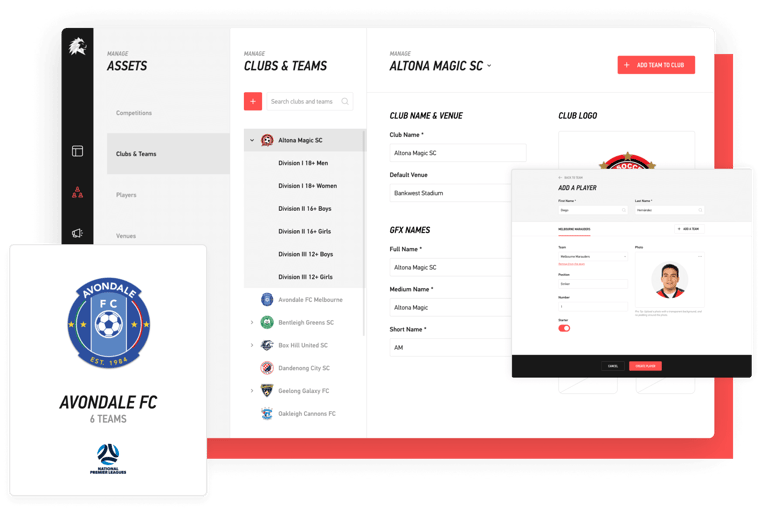
The dashboard is a web-based interface that allows a user to generate graphics overlays for broadcasts, manage their graphic assets such as sports and advertising assets, and more. The dashboard is the primary interface for controlling all aspects of LIGR.Live.
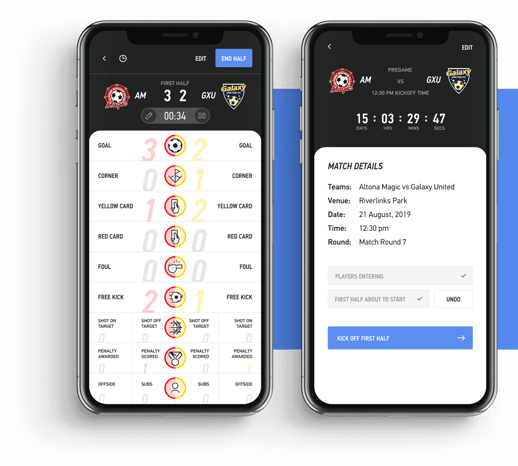 The LIGR LiveScore app provides an easy and user-friendly way to populate your live sports graphics with match data. The app can operate on any web-enabled device. However, it is best to run on a portable device such as a smartphone or a tablet.
The LIGR LiveScore app provides an easy and user-friendly way to populate your live sports graphics with match data. The app can operate on any web-enabled device. However, it is best to run on a portable device such as a smartphone or a tablet.

The control room allows the user to have complete control over when to show and hide a particular graphic on a live broadcast. The control room is also a way to customize the information displayed on certain live graphics such as a lower third—where the user can input their desired text into the graphic manually. LIGR’s control room is a new, unique take on manual graphics operation, offering a stunning and effortless-to-use user interface.
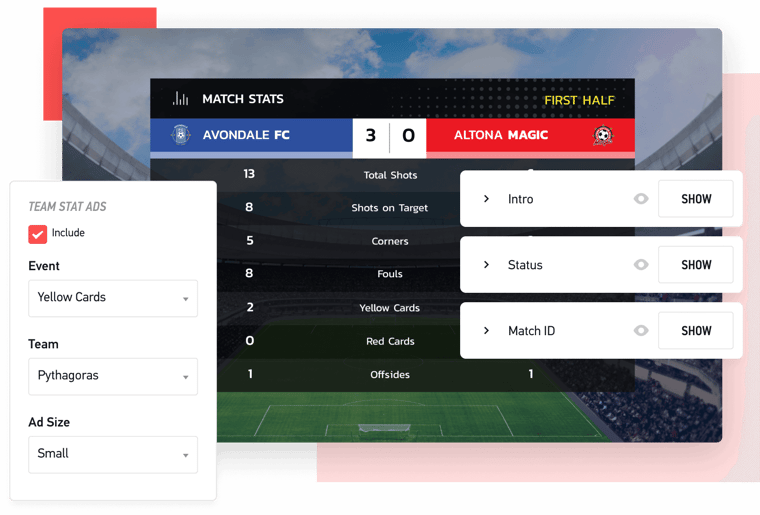
Each LIGR graphics overlay renders in the cloud and displays via a unique URL that a user generates from the LIGR.Live dashboard. LIGR's graphics overlays operate into two modes: auto-mode and manual-mode.
- Auto-mode: It tells the graphics to show and hide on the live stream automatically. The live match data that is received by LIGR drives the logic behind this automation. For instance, goal scored = display goal scored graphic.
- Manual-mode: It tells the graphics overlay to wait for user input before either showing or hiding a graphic on the live stream.
For example, the user physically clicks the "show" button to display a particular graphic.
Let's talk about a few different scenarios on how LIGR.Live's workflow could be used:
1. LiveScore on-site, overlay off-site.png?width=970&name=LAPTOP_SOCCER_THEME%20(1).png)
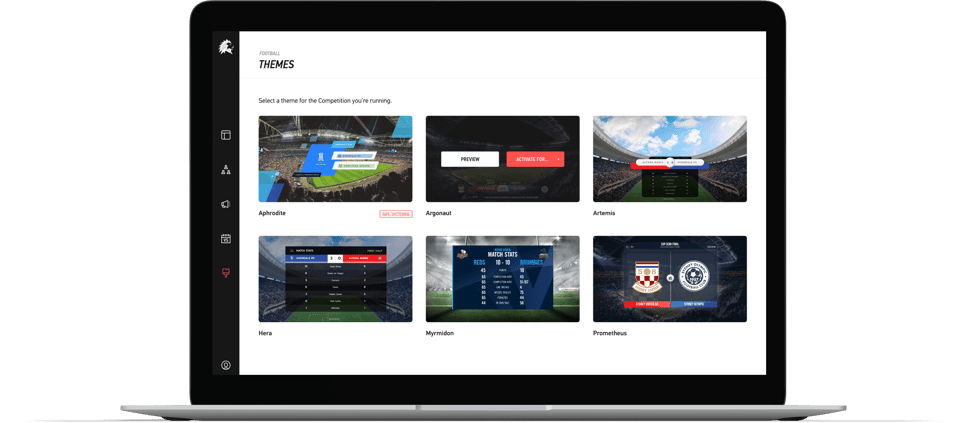 Select your live graphics theme within the LIGR.Live Dashboard
Select your live graphics theme within the LIGR.Live Dashboard 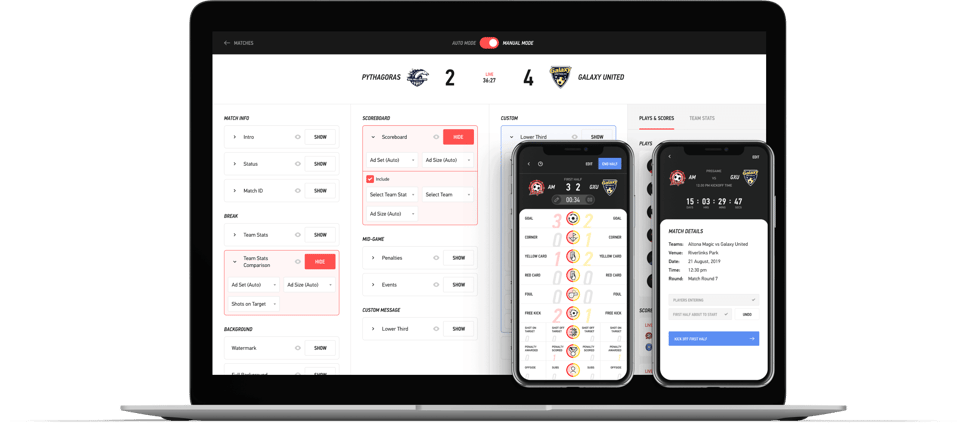
Brands and sponsors of live sports see the opportunity in the new era of OTT sports broadcast. In essence, it is live-streamed aggregated content on common viewing platforms. However, without a next-gen live graphics platform to integrate their assets seamlessly and professionally into the in-game live content at important moments, and then to report back on when and how their assets are displayed, it’s an impossible game. A great next-gen graphics solution must make reporting possible and efficient. Also, it should improve the display for broadcasters, the league and the brand.
However, at LIGR, we knew that in a world of unlimited demand, with greater localized and dispersed audiences, a live graphics platform for live sports in an OTT world had to be just as much a sponsor display and report platform. Without the latter, the former holds infinitely less value, as sports broadcasts commercialize through external sponsors. It’s a model that works because live sports are still the most valuable in terms of generating and engaging audiences and eyeballs globally. For sponsors who value those audiences, it is still the best way to engage them and promote your brand—whether globally, nationally, or locally.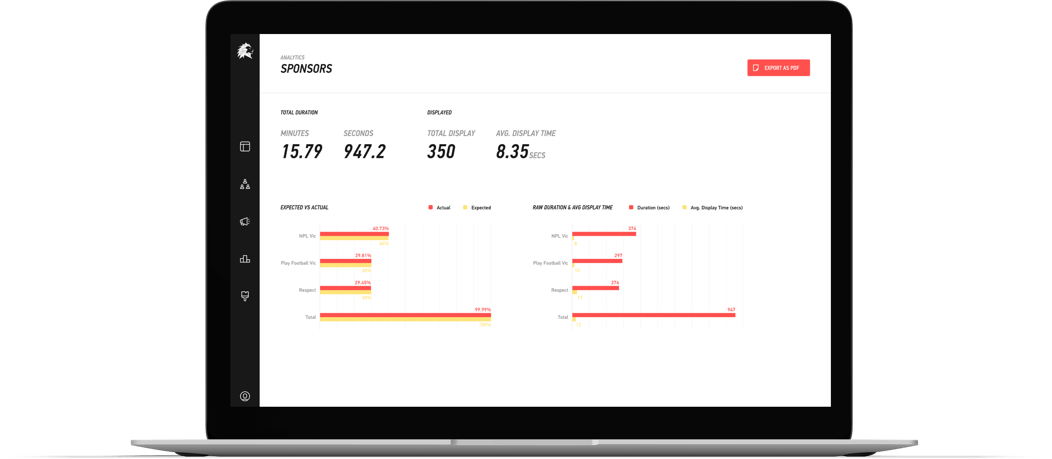
LIGR.Live reporting dashboard